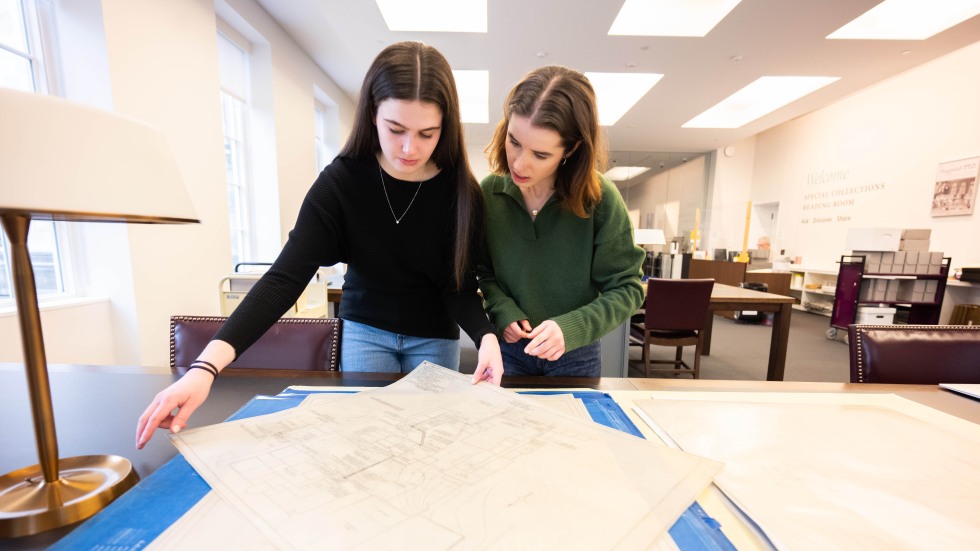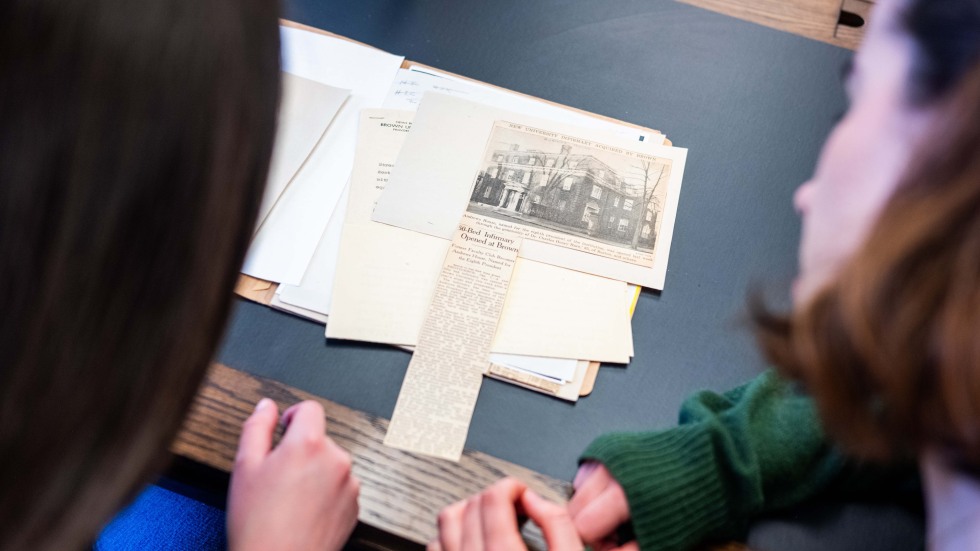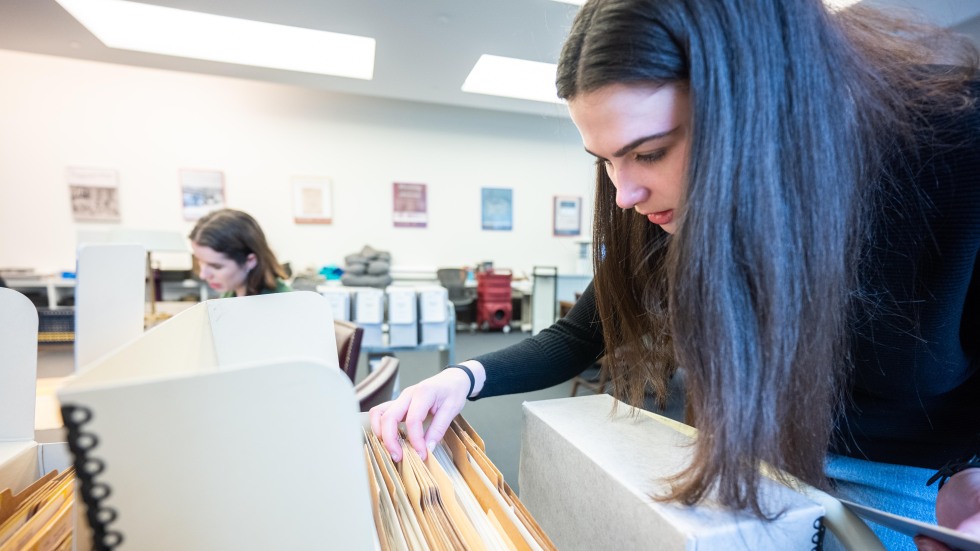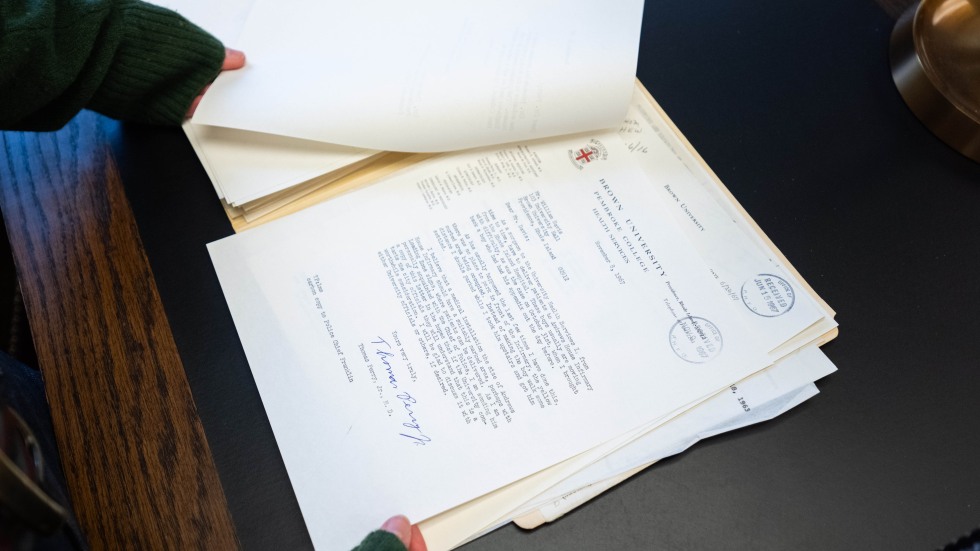PROVIDENCE, R.I. [Brown University] — Kate Harty and Catherine Manning’s faces lit up as they surveyed the many boxes and folders of memos, blueprints, newspaper clippings and other documents that awaited them in the Special Collections Reading Room at Brown University’s John Hay Library.
“This is fascinating,” Harty said as she began looking through one of the folders. “We have the chance to sort through these artifacts and piece together a picture of life in a different time.”
For the pair of history concentrators at Brown — Harty, a senior, and Manning, a junior — it’s been a thrilling opportunity to devote a semester to hands-on research about the University’s 123-year-old Andrews House and help support a key moment for Brown’s Cogut Institute for the Humanities, which is set to move into the newly renovated building this summer.
Through Brown’s expansive Undergraduate Teaching and Research Awards program, which funds student and faculty collaboration, the students explored the building’s history under the research supervision of Damien Mahiet, director of academic programs for the Cogut Institute.
“As Cogut prepares to make a new home for humanities scholars, researchers and students, we thought it would benefit the community to understand who previously used the space and for what purposes,” Mahiet said. “Our goal was to further the understanding of the space within which humanities scholars would be working and to make public its historical significance.”

For months, construction crews have been extensively renovating and restoring the building at 13 Brown St. in Providence, which was built in 1901 as a textile manufacturer’s mansion and has been owned by Brown since 1922. Meanwhile, in the library, the research team discovered new and expanded information about the building’s history that will be incorporated into the Cogut Institute’s website, building tours, materials and more.
“We feel that the work we’ve been doing this semester really matters for the Brown community — and also to Rhode Islanders more generally,” Manning said. “We have been looking at documents that most likely no one has taken the time to examine in this way before. A lot of these facts have probably been forgotten over time, so this has been a super interesting experience as a history student.”
From high society to hospital: A journey through the archives
Andrews House has a fascinating history that is intertwined with the growth of the University, according to the researchers. Home to Brown University’s Health Services for eight decades, and the Brown Faculty Club before that, the four-story building is named in honor of the University’s eighth president, E. Benjamin Andrews. While many facts about 13 Brown St. were already publicly known, the researchers dug deeper to understand the full history of the building and correct minor errors in the historical record.
Harty, Manning and Mahiet combed through newspaper clippings and found hundreds of references to the building, its address and its occupants. They also explored more than a dozen folders and boxes of administrative records and correspondence at the John Hay Library. And they studied architectural drawings of the building and its various renovations over the years. Throughout the semester, the trio met weekly to discuss their findings and plan future work.
Among the people they researched was the stately brick building’s architect, Ogden Codman Jr., who with the novelist Edith Wharton wrote the 1897 book, “The Decoration of Houses,” in which they advocated for a rejection of Gilded Age excess in favor of simplicity and balance.
The team also learned about the home’s first occupants: thread manufacturer Alfred M. Coats and, later, the 52nd governor of Rhode Island, Robert Livingston Beeckman, who leased the property from the Coats family from 1915 to 1921 during his term in office.
“Alfred M. Coats played an important role in the industrial history that ties Providence and Pawtucket with the British textile industry,” Mahiet said. “And like Gov. Beeckman, he appeared in the society pages of Providence, Newport and New York newspapers as a known figure of the East Coast elite.”
Born in Scotland, Coats oversaw more than 2,000 workers in the first decade of the 20th century as general manager of the J&P Coats plant in Pawtucket, Rhode Island. He later served as Rhode Island’s federal food administrator during World War I. Coats’ prominent social standing, Mahiet said, influenced Codman’s design of the building, with a grand first floor meant for large-scale entertainment and assembly, with more intimate second- and third-floor spaces.






